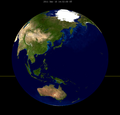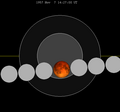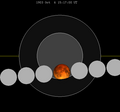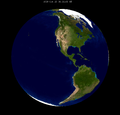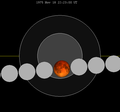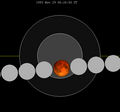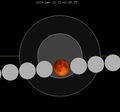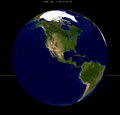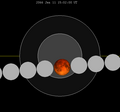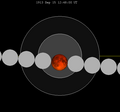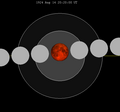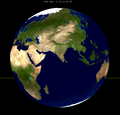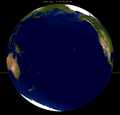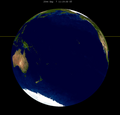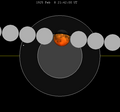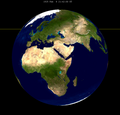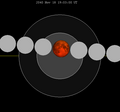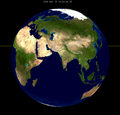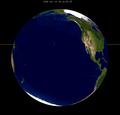December 2011 lunar eclipse
A total lunar eclipse occurred at the Moon’s descending node of orbit on Saturday, December 10, 2011,[1] with an umbral magnitude of 1.1076. A lunar eclipse occurs when the Moon moves into the Earth's shadow, causing the Moon to be darkened. A total lunar eclipse occurs when the Moon's near side entirely passes into the Earth's umbral shadow. Unlike a solar eclipse, which can only be viewed from a relatively small area of the world, a lunar eclipse may be viewed from anywhere on the night side of Earth. A total lunar eclipse can last up to nearly two hours, while a total solar eclipse lasts only a few minutes at any given place, because the Moon's shadow is smaller. Occurring about 4.8 days after apogee (on December 5, 2011, at 20:10 UTC), the Moon's apparent diameter was smaller.[2] VisibilityThe eclipse was completely visible over east and northern Asia, Australia, and northern North America, seen rising over Europe and east and central Africa, and setting over North America.[3]
Images GalleryAsia
Australia and Oceania Europe and Middle East
North America
TimingTimes for AustraliaThe eclipse occurred on Saturday evening in Australia. Eastern Daylight Saving Time: (+11:00 UTC)
Times for IndiaThe eclipse was visible from India in the evening, given in India Standard Time (UTC+5:30):
Times for North AmericaThe eclipse was visible on Saturday morning before sunrise over North America. For most locations, the moon set before full lunar eclipse. Only Alaska and northernmost Canada will be able to witness the entire event.
Eclipse detailsShown below is a table displaying details about this particular lunar eclipse. It describes various parameters pertaining to this eclipse.[4]
Eclipse seasonThis eclipse is part of an eclipse season, a period, roughly every six months, when eclipses occur. Only two (or occasionally three) eclipse seasons occur each year, and each season lasts about 35 days and repeats just short of six months (173 days) later; thus two full eclipse seasons always occur each year. Either two or three eclipses happen each eclipse season. In the sequence below, each eclipse is separated by a fortnight.
Related eclipsesEclipses in 2011
Metonic
Tzolkinex
Half-Saros
Tritos
Lunar Saros 135
Inex
Triad
Lunar eclipses of 2009–2013This eclipse is a member of a semester series. An eclipse in a semester series of lunar eclipses repeats approximately every 177 days and 4 hours (a semester) at alternating nodes of the Moon's orbit.[5] The penumbral lunar eclipses on February 9, 2009 and August 6, 2009 occur in the previous lunar year eclipse set, and the lunar eclipses on April 25, 2013 (partial) and October 18, 2013 (penumbral) occur in the next lunar year eclipse set.
Saros 135This eclipse is a part of Saros series 135, repeating every 18 years, 11 days, and containing 71 events. The series started with a penumbral lunar eclipse on April 13, 1615. It contains partial eclipses from July 20, 1777 through October 28, 1939; total eclipses from November 7, 1957 through July 6, 2354; and a second set of partial eclipses from July 16, 2372 through September 19, 2480. The series ends at member 71 as a penumbral eclipse on May 18, 2877. The longest duration of totality will be produced by member 37 at 106 minutes, 13 seconds on May 12, 2264. All eclipses in this series occur at the Moon’s descending node of orbit.[6]
Eclipses are tabulated in three columns; every third eclipse in the same column is one exeligmos apart, so they all cast shadows over approximately the same parts of the Earth.
Tritos seriesThis eclipse is a part of a tritos cycle, repeating at alternating nodes every 135 synodic months (≈ 3986.63 days, or 11 years minus 1 month). Their appearance and longitude are irregular due to a lack of synchronization with the anomalistic month (period of perigee), but groupings of 3 tritos cycles (≈ 33 years minus 3 months) come close (≈ 434.044 anomalistic months), so eclipses are similar in these groupings.
Inex seriesThis eclipse is a part of the long period inex cycle, repeating at alternating nodes, every 358 synodic months (≈ 10,571.95 days, or 29 years minus 20 days). Their appearance and longitude are irregular due to a lack of synchronization with the anomalistic month (period of perigee). However, groupings of 3 inex cycles (≈ 87 years minus 2 months) comes close (≈ 1,151.02 anomalistic months), so eclipses are similar in these groupings.
Half-Saros cycleA lunar eclipse will be preceded and followed by solar eclipses by 9 years and 5.5 days (a half saros).[8] This lunar eclipse is related to two total solar eclipses of Solar Saros 142.
See also
References
External linksWikimedia Commons has media related to Lunar eclipse of 2011 December 10.
Live Webcasts
|
||||||||||||||||||||||||||||||||||||||||||||||||||||||||||||||||||||||||||||||||||||||||||||||||||||||||||||||||||||||||||||||||||||||||||||||||||||||||||||||||||||||||||||||||||||||||||||||||||||||||||||||||||||||||||||||||||||||||||||||||||||||||||||||||||||||||||||||||||||||||||||||||||||||||||||||||||||||||||||||||||||||||||||||||||||||||||||||||||||||||||||||||||||||||||||||||||||||||||||||||||||||||||||||||||||||||||||||||||||||||||||||||||||||||||||||||||||||||||||||||||||||||||||||||||||||||||||||||||||||||||||||||||||||||||||||||||||||||||||||||||||||||||||||||||||||||||||||||||
Portal di Ensiklopedia Dunia







































